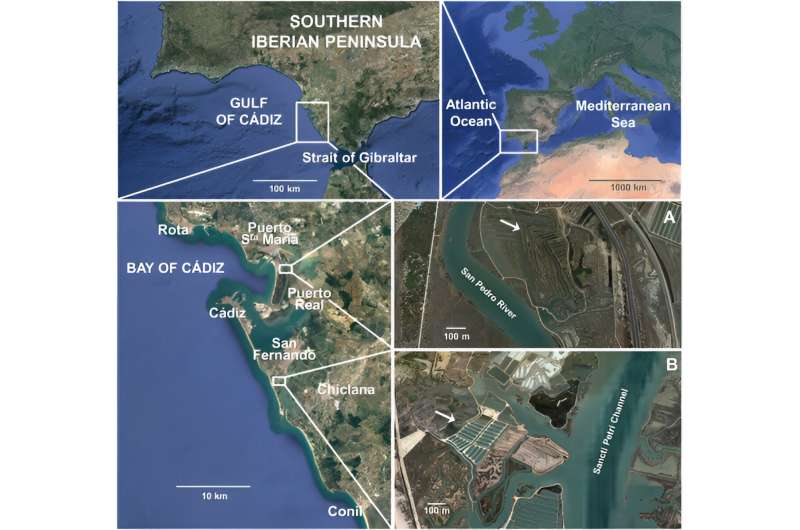This article has been reviewed according to Science X's editorial process and policies. Editors have highlighted the following attributes while ensuring the content's credibility:
fact-checked
trusted source
proofread
Study shows that the estuaries in the Bay of Cádiz are a treasure trove for ecological fish farming

A study, published in Marine Environmental Research and led by José Manuel Guerra García, professor at the Department of Zoology of the Faculty of Biology of the University of Seville, reveals that gilt-head sea bream farmed in estuaries in the Bay of Cadiz show many similarities to wild gilt-head sea bream.
According to the Food and Agriculture Organization of the United Nations (FAO), aquaculture is an activity aimed at producing and fattening aquatic organisms in their environment. It is also defined as the cultivation under controlled conditions of species that develop in the aquatic environment (fish, mollusks, crustaceans and algae) and that are useful to humans. The marine environment can thus become an excellent area for the exploitation of natural resources.
Aquaculture is booming and will ensure future fish and seafood consumption in a world where fish stocks are overexploited.
In view of the growing importance of this sector, national and international directives aim to achieve crops that are increasingly environmentally sustainable. In this sense, the researchers propose the estuaries as ecosystems of high ecological value that are perfect for the cultivation of crops that are respectful and compatible with conservation. In estuaries, fish enjoy a suitable environment and can feed on small invertebrates, mainly crustaceans, which grow naturally in the estuary.
A study that focuses on gilt-head sea bream's diet
Scientists' work has focused on the trophic characterization of their diet (through the study of prey found in stomach contents and rigorous stable isotope analysis), as well as on the quantification of heavy metal concentrations in gilt-head sea bream (Sparus aurata).
The results show that in extensive estuaries gilt-head sea bream have a very rich diet, especially in decapod crustaceans, and the isotopic profile has a high trophic amplitude and is similar to that obtained for wild gilt-head sea bream in the Bay of Cádiz. Furthermore, the heavy metal concentrations of the fish in the estuaries are below the legal limits set by national and international regulations, thus guaranteeing safe consumption.
The estuaries of Cadiz, the best home for fish
The estuaries, salt marshes and marshlands of the Bay of Cadiz are natural spaces that represent one of the most important coastal wetlands in Europe. These ecosystems reflect a mix of tradition, gastronomy and conservation of flora and fauna, and are optimal locations to develop fish farming in an environmentally responsible manner. The development of quality seals, such as the "Pescado de Estero" brand, is necessary to promote this product.
Scientists like José Manuel Guerra insist on the need for the competent authorities to highlight the importance of the estuaries. This awareness is crucial not only to prevent their disappearance, but also to transform them into an important source of economic resources for the area, through the production of high-quality fish.
More information: J.M. Guerra-García et al, Farming Sparus aurata (Teleostei: Sparidae) in marsh ponds: trophic characterization and trace metal accumulation, Marine Environmental Research (2023). DOI: 10.1016/j.marenvres.2023.106007
Provided by University of Seville




















